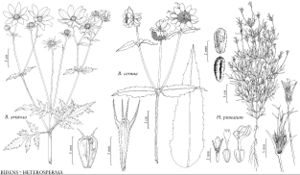Heterosperma
Icon. 3: 34. 1795.
| Taxon | Illustrator ⠉ | |
|---|---|---|
 | Bidens aristosa Bidens cernua Heterosperma pinnatum | Yevonn Wilson-Ramsey Yevonn Wilson-Ramsey Linny Heagy |
Annuals, 10–40 (–70+) cm (taprooted). Stems 1 (bases relatively thick), ascending to erect, branched distally or ± throughout (striate). Leaves mostly cauline; opposite; obscurely petiolate or sessile; blades mostly pinnately lobed [undivided] (lobes 3–5, usually linear to filiform, sometimes lanceolate), ultimate margins usually entire, sometimes denticulate (often ciliate, at least proximally, apices acute), faces glabrous [hairy]. Heads radiate, borne singly or in loose, cymiform arrays. Calyculi of (1–) 3–5+ erect, narrowly spatulate or linear to filiform, herbaceous bractlets (often surpassing phyllaries, margins usually hispid-ciliate). Involucres cylindric to obconic, 2–5 mm diam. (larger in fruit). Phyllaries 3–5+ in ± 2 series, distinct, erect, mostly oblong or ovate, equal, membranous. Receptacles concave to flat, paleate; paleae similar to phyllaries, oblong or oval to lanceolate or linear (± embracing cypselae, ± hyaline with brown striae, apices obtuse, apiculate). Ray-florets 1–3 [–8], pistillate, fertile; corollas pale-yellow [orange]. Disc-florets 3–10 [–20+], bisexual, fertile; corollas ± yellow (at least distally), tubes shorter than funnelform throats, lobes 5, deltate. Cypselae (± dimorphic) outer obcompressed, ellipsoid or obovoid, winged (wings ± corky, often cucullate and/or pectinate), faces often corky-tuberculate, glabrous, inner ± obovoid, usually some (innermost) tapered to ± barbellate beaks; pappi 0, or persistent or tardily falling, of (1–) 2–3 spreading to reflexed, retrorsely barbellate awns. x = 25.
Distribution
sw United States, Mexico, Central America, South America, in West Indies
Discussion
Species 5–10 (1 in the flora).
Selected References
None.
Lower Taxa
"broader" is not a number.